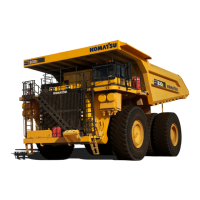J5-6 Rockwell Wheel Speed Front Disc Brakes 10/06 J05024
Cleaning and Inspection
1. Preliminary cleaning can be more effective if lin-
ings are first removed. However, retaining
plates should be temporarily reinstalled in order
to stay with brake assembly through overhaul
cycle.
Use care when wiping dust shields. Too much
pressure on shield over sharp tip of housing cav-
ity may cause dust shield to be cut.
2. Cleaning may be done by brush or spray, using
a petroleum base cleaning solvent. Clean diesel
fuel is acceptable for this operation. Cleaning
should be thorough enough for preliminary
inspection and disassembly. Subassemblies
should be blown dry with compressed air after
cleaning. Dust shields should be wiped dry with
a clean cloth.
NOTE: If brake has not accumulated excessive
surface dirt, preliminary cleaning can be done in the
overhaul area. However, it is recommended that
preliminary cleaning be done before removal of
pistons from housings.
3. Inspect dust shields (10, Figure 5-3) for any
physical damage or rupture, and any hardening,
cracking, or deterioration of material from
excessive heat. Failure of dust shield can admit
dirt to the piston cavity, causing damage to sur-
face finish of piston and cylinder wall, and dam-
age to seal. If dust shields are found to be soft
and pliable, with no sign of hardening or crack-
ing, they should be wiped clean and set aside
for reuse.
4. Inspect piston cavities and surfaces of piston
for evidence of dirty fluid, particularly if dust
shields were ruptured.
5. Inspect piston cavities for evidence of varnish
formation, caused by excessive and prolonged
heating of brake oil.
Piston should be handled with care. The usual
cause of nicked piston surfaces is mishandling
during the cleaning procedure.
Steel tools should never be used in piston cavi-
ties and seal grooves. Copper, brass, aluminum,
wood, etc. are acceptable materials for such pur-
poses.
NOTE: All seals (12, Figure 5-3) should be replaced
at assembly.
6. Inspect piston (11) surfaces for scratches,
excessive wear, nicks, and general surface fin-
ish deterioration that can contribute to seal
damage and fluid leakage.
NOTE: In normal operation, a very slow rate of wear
should be experienced, and will be noticeable by the
slow disappearance of the hard chrome finish. Minor
nicks and scratches may be blended out by hand
with 180 grit aluminum oxide or carborundum cloth,
then successively finer grades used until a surface
comparable to the original surface is obtained.
Extensive local polishing should be avoided, since
the minimum piston diameter is 91.923 mm (3.619
in.). The piston finish is important in providing a
proper seal surface and seal wear life. Where
surface finish has deteriorated beyond restoration by
moderate power buffing with a fine wire brush, piston
should be replaced. Determination of ideal surface
finish quality can be made by comparison with a new
piston. Surface roughness of piston face through
contact with lining back plate is not detrimental to its
operation, and is a normal condition.

